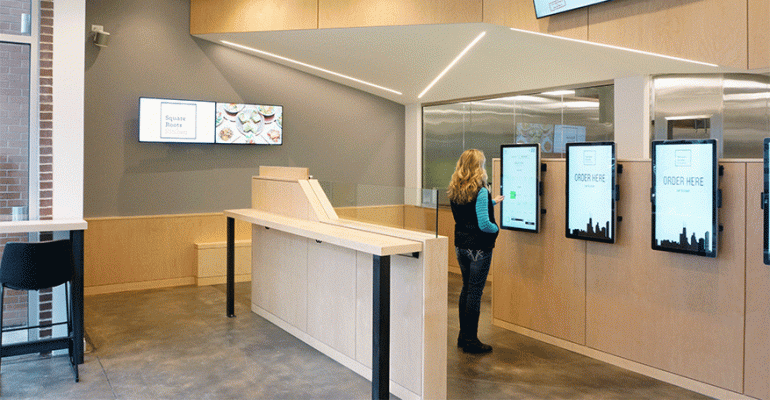The kiosk movement comes at a time when the IT department at a restaurant company is becoming equally as crucial as menu development or operations.
That’s especially true for startups. Many are designing restaurants around tech instead of treating them as digital accessories.
Take Square Roots Kitchen in Chicago.
The year-old 1,600-square foot startup is outfitted with five, 32-inch wall mounted touchscreen tablets. There are no cashiers.
Founder Derin Alemli said his business model calls for marrying technology with a simplified back-of-the-house meal assembly system that requires fewer employees.
“We’re a tech-enabled restaurant,” said Alemli, a self-described serial entrepreneur with an MBA from the University of Chicago.

Spyce opened this year with five touchscreen kiosks.
Alemli, 33, initially launched Square Roots Kitchen in 2015 as a ghost restaurant, with no storefront, focused only on catering. He leveraged catering apps such as ZeroCater and Fooda to promote Square Roots Kitchen’s healthy menu of salads, wraps and bowls. After proving the concept, he opened the first brick-and-mortar restaurant last year in downtown Chicago near a Whole Foods Market.
The Square Roots Kitchen touchscreen tablets display large size fonts and eye-popping food images, making it easy and enticing for customers to build their meals.
“We knew we wanted to go big and bold. There’s no ambiguity,” Alemli said.
After ordering, guests can watch their food being prepared by a food assembler standing behind a glass partition. A typical order is ready in under 90 seconds.
On a drizzly Friday in May, several 20-something customers walked in wearing headphones and gym clothes. One mother rocked her baby in a stroller while entering her order with her other hand. Each guest approached the kiosk without fear, walking away with a to-go order within a few minutes. They talked to no one even though Alemli was standing nearby ready to assist anyone in need.
And, that’s the goal: Convenience, speed and personalization without sacrificing food quality. Alemli is happy with the results. He said roughly 90 percent of the restaurant’s revenue comes from returning customers.
In Pasadena, Calif., CaliBurger is piloting a state-of-the art kiosk system that’s earned the emerging brand national buzz.

CaliBurger is piloting a state-of-the-art kiosk system with face recognition technology.
The Southern California location, among 10 domestic CaliBurgers, recently added face recognition technology to its two in-store kiosks. Like an iPhone X, the kiosk scans your face to unlock your profile. Profiles, or facial fingerprints, are created after the first visit.
Once a guest is recognized, he or she can create a new burger order, or reorder one of three past meals displayed onscreen. When done, the monitor prompts guests to “Pay by Face” with a credit card tied to their account. No swiping is needed after registering for the first time, unless a guest wants to use a different form of payment.
Ultimately, it takes four clicks to order and pay for food, said Yale Goldberg, vice president of business development at Pop IQ, the facial recognition software developer.
“We want it to be as seamless as possible,” Goldberg said.
 Pop IQ is owned by Pasadena, Calif.-based Cali Group, the same parent company of CaliBurger.
Pop IQ is owned by Pasadena, Calif.-based Cali Group, the same parent company of CaliBurger.
With the kinks worked out in Pasadena, CaliBurger — also home to an experimental burger-flipping robot — plans to roll out the facial recognition technology to five other U.S. restaurants within the next two weeks.
More locations will soon follow in the U.S., Canada, Mexico, Europe and the Middle East.
Another indie brand earning buzz is Boston-based Spyce. It opened this year with five touchscreen kiosks, a robotic kitchen developed by M.I.T. students and a menu endorsed by key investor, French chef Daniel Boulud.
The rise of these tech-driven, automated restaurants underscores the reshaping of labor demands in certain retail and restaurant industries, according to a May 2018 report by McKinsey Global Institute.
The need for physical and manual skills has been declining for 15 to 20 years, and will continue to slide with automation, the report shows. Between 2016 and 2030, demand for those basic skills will fall by 11 percent in the United States, the McKinsey report stated.
“Jobs that remain will tend to be concentrated in customer service, management, and technology deployment and maintenance,” the McKinsey report.
Besides convenience and speed, kiosks offer another lucrative perk: higher checks.
At Burger Boss, which has six locations in Southern California, kiosk orders are about $2 more than checks made at the counter.

At Burger Boss, kiosk orders are about $2 more than checks made at the counter.
“We think customers tend to order more because they have more time to customize,” said Kamil Finan, chief operations officer of the Corona, Calif.-based build-your-own burger concept.
Every time a customer selects an entrée, the kiosk automatically asks the customer if they want to add a beverage or a baked good. The prompt also comes with tempting visual images, which aid in the upselling, he said.
Controlling an order without human interaction is also driving frequency, some operators say.
“Millennials don’t like to talk to human beings,” Finan said.
Future iterations of their kiosk system will recall a customer’s last order. It will also have an “experiential” component by allowing guests to share images of their custom-built grass-fed burgers on their social pages.
Contact Nancy Luna at [email protected]
Follow her on Twitter: @FastFoodMaven





